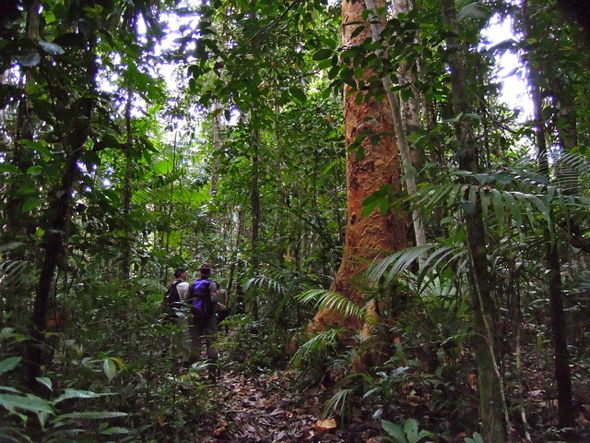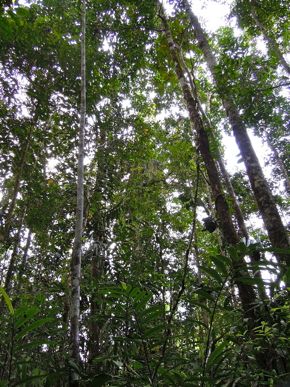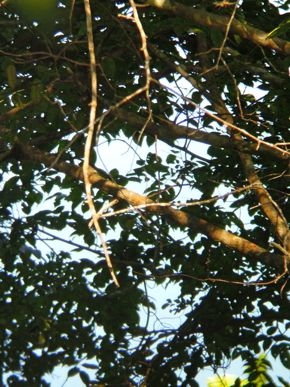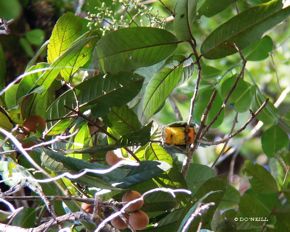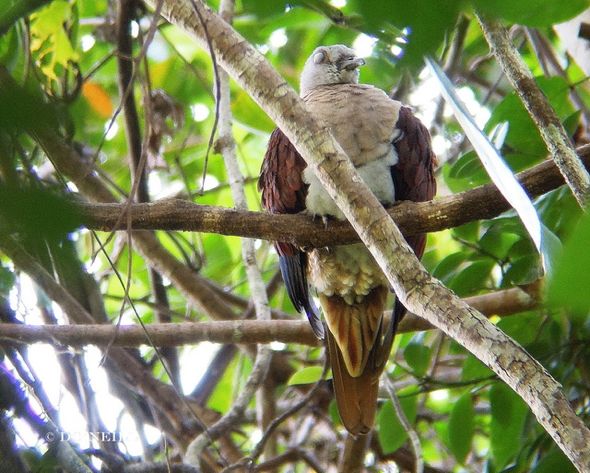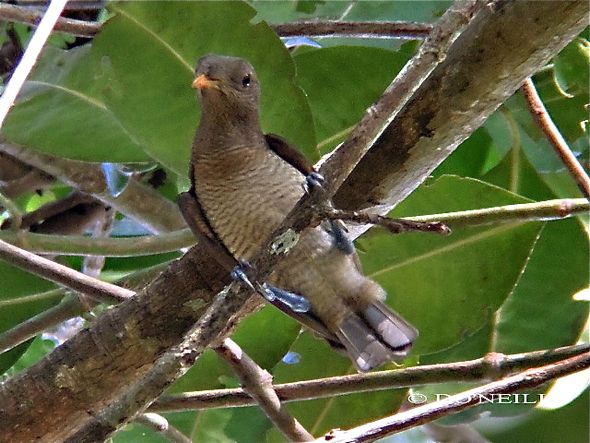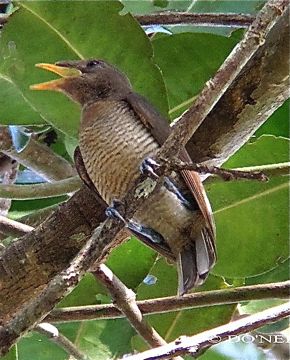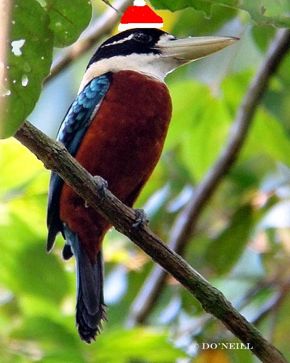“How does an observer, having first sighted a bird, convey its location to a second bird observer?
“Does he/she finger point direction of the bird and or proceed to provide a lengthy description of its exact location? Something like-‘behind that twisted branch… towards the right, just next to a big leaf, a bit further up, next to the other tree’ etc.. amongst a host of other trees, only much to viewers’ dismay, see the bird takes flight.
“Why do birds fly away the minute we finger point directly at them?
“Bird guides using laser pointers to pinpoint quality birds from great distances to their guests, too have their fair share of missed opportunities.
“It looks like birds have extraordinary inborn, sensory detector mechanisms with the ability to detect the slightest kinetic vibration energy released from human finger tips or a hard consistent stare or by laser beams.
“Such natural gifts endowed to birds protect them further from impending threat of danger and predation. Their worst enemies unfortunately are Homo sapiens.
“Birding under Papuan’s luxuriant virgin forests cover, poses a different kind of challenge where good, sharp eyesight alone is insufficient to see birds as compared to birding in degraded tropical rainforests (top and above).
“In the first two days of my expedition to Papua, our team saw little. I don’t think there were no birds but rather, walking under such subdued lighting conditions, it was not easy to discern even colourful, perched, motionless birds amongst tree branches or against foliages – many of great heights or may just be six metres away.
The image on the left shows the Beautiful Fruit-Dove (Ptilinopus pulchellus).
“Our eyes needed time to adjust to the local lighting conditions. Our much required local and specialised bird guides- though not endowed with bionic eyes – were making great efforts to show whereabouts or nearby where endemic New Guinea birds may be found.
Image above shows Pinon Imperial-pigeon (Ducula pinon). Below shows Zoe Imperial-pigeon (Ducula zoeae).
“Birds are generally territorial, some with own quaint habits and built-in biological clock that would show up at the correct time.
“Whenever bird sighting opportunities arose, finger pointing was the order of the day and viewers saw mainly birds took to frightful flights.
“Sighting a chasing pair of King Bird of Paradise (Cicinnurus regius) finally broke the camel’s back. The female showed up through my Fieldscope lens at 7 O’clock direction after an exhaustive description from the guides-much to their relief having to patiently cater to a senior! (above).
“The bird’s branch perch was a tall tree no less than 100 metres away. The skills of long distance digiscopy put to the ultimate challenge with the naked eye that saw… only a tiny, blurry brown dot!
“My back was screaming in agony, patience was just about frayed by frustration as a satisfactory reference to the bird’s location was not at hand.
“Photographing the bird was finally made possible with local guide Maurits directing his laser pointer and my instruction to draw a circle clock around the bird- being the centre.
“Flamboyant males of Birds of Paradise usually take precedence in colourful photography. They are well painted and recently documented. Females in most species are generally plain, fawn colour and often get neglected. However, in the use of field guides and scientific references, juveniles and females are equally important as the males.
“Image on the left shows a rare, neck-breaking, disgiscoped image of the same female King Birds of Paradise with maximum zoom and photo shopped to death. Female was calling to her mate.
“My recent bird expedition trip to Papua made me to realise, much is needed to device and share an acceptable field craft method – a more jiffy, simple and enjoyable approach for bird guides and their foreign visiting guests, birders and b-photographers alike to view quality birds in unfamiliar environment.
“Wouldn’t it be nice to adopt a given quick, standard and universal reference that each bird enthusiast can quote, understand and practice in the field?
“How does this sound as an answer example for a quick bird direction?
‘Brown bird tree perch 7 O’clock, 100m away, eye elevation 70 degrees?’
“How does it work?
“Visual Location of Bird using ©Clock-N-Angle Method
Field example 1 – Understanding the clock
“2 Observers take to a trail- one behind each other. Let their standing position be centre point of an imaginary clock drawn on ground.
For direction:
Observer/s looking in front of the trail be 12 O’clock.
Observer/s directly behind be 6 O’clock.
Observer/s raised Right to arm shoulder level be 3 O’clock.
Observer/s raised Left arm to shoulder level be 9 O’clock.
Measuring Distance:
only two simple things one needs to put into practice from home and a few blinks of visualisation are all that is needed to learn this simple technique.
1) Learn to visualise distance measurement (Metric or Imperial). Pre-measure with ruler/tape on walls or hallway of your house.
2) Familiarise oneself with mental conversion. Metric to Imperial or vice-versa (1m=3.3ft Approx.)
“Having determined Direction and Distance of bird what’s next?
Visual height of bird using eye elevation angle.
“Let Observer/s looking front at eye level be angle O degrees.
Looking up at the sky the angle be 90 degrees.
Position view for canopy birds – Anything below eye level may at best and easy to quote position of bird by distance in feet/metres above ground level.
The rule of thumb is to keep things simple and doing what is best comfortable for oneself and be kind to the birds.
“Readers may want to note that when conveying direction to a second observer who is at least one foot taller, the latter’s eye angle will be less acute.
“There could be a 10-15 degree angle difference. (e.g. If 1st observer’s angle view is 30 degrees, 2nd observer’s angle will be about 20 degrees. This is the correct angle to quote to the relevant, taller person that Observer 1 is prompting to.)
Field Example 2- Facing the Clock
“If observers are facing the horizon, across the river, looking into a forests etc… place the imaginary clock in hanging/upright position.
“Determination of the clock centre will be at first observer’s discretion and agreeable to other observers. Read the time clock where the bird perches.
“My personal choice to determine the clock centre point is a prominent tree with canopy – where the top end main tree trunk meets the first branch spreading out as seen in this photograph on the left.
Field Example 3 – Ground Zero
“Observers looking for terrestrial birds would need to be in squat/sit position in which case, the imaginary clock will be on ground. Hardly any eye level angle needed. Just look onto the ground.
“Now, does this phrase make more sense than before?
‘Brown bird tree perch 7 O’clock, 100m away, eye elevation 70degrees’
“Not every birder or B-photographer in the past came through attending birding classes made available at the various clubs, societies in their own local areas. Some learnt the D-I-Y way- acquiring their own field craft by experience or follow the crowd blindly or otherwise. Those who did, I don’t seemed to see, hear anyone practicing such basic field craft fundamentals.
“An accidental meet up with participant members of Exonexion Expeditions Inc. in Papua provided the opportunity to sow the ‘Clock’ seeds. They have begun growing wings. My fated team mates- K and Renuka from Thailand made this trip possible. They left their footprints in their E-book with an encouraging comment that mentions, ‘To tell Daisy where the bird is, you have to give her ‘TIME.’
“Yes, time will tell and what goes around comes around. I look forward to the day where I would meet a birder/b-photographer- be it a senior or a fresh upstart prompts me a bird using the ©Clock-N-Angle Method.
“I know the birds would have rejoiced and perhaps too my time in ornithology is just about served….
“Readers, individuals, clubs, societies etc. are most welcome to try the ©Clock-N-Angle Method. If they work good, feel free to put into practice, provide the attributions and share with your fellow mates. That would be Avian Writer’s gift for readers this holiday season.
The image above-right shows the Rufous-bellied Kookaburra (Dacelo gaudichaud).
“Happy Holidays & All Best for the New Year!.”
Avian Writer Daisy O’Neill
Penang, Malaysia
17th December 2012
Copyright article and copy Images:
Courtesy of Daisy O’Neill Bird Conservation Fund


